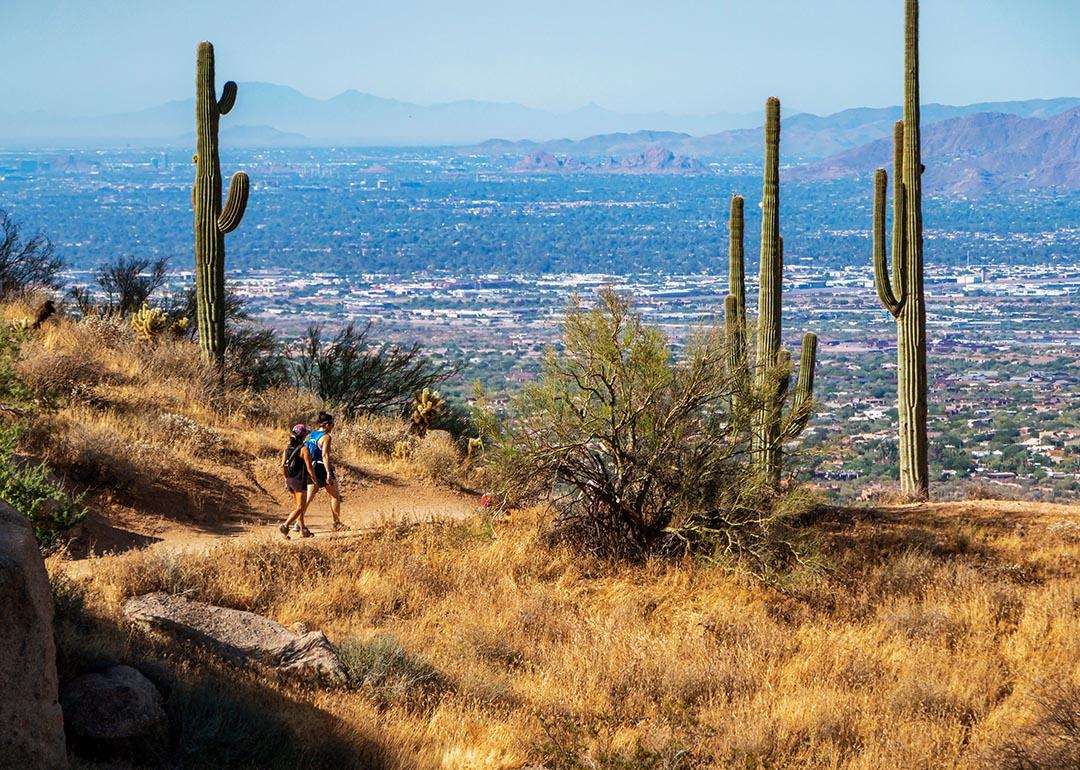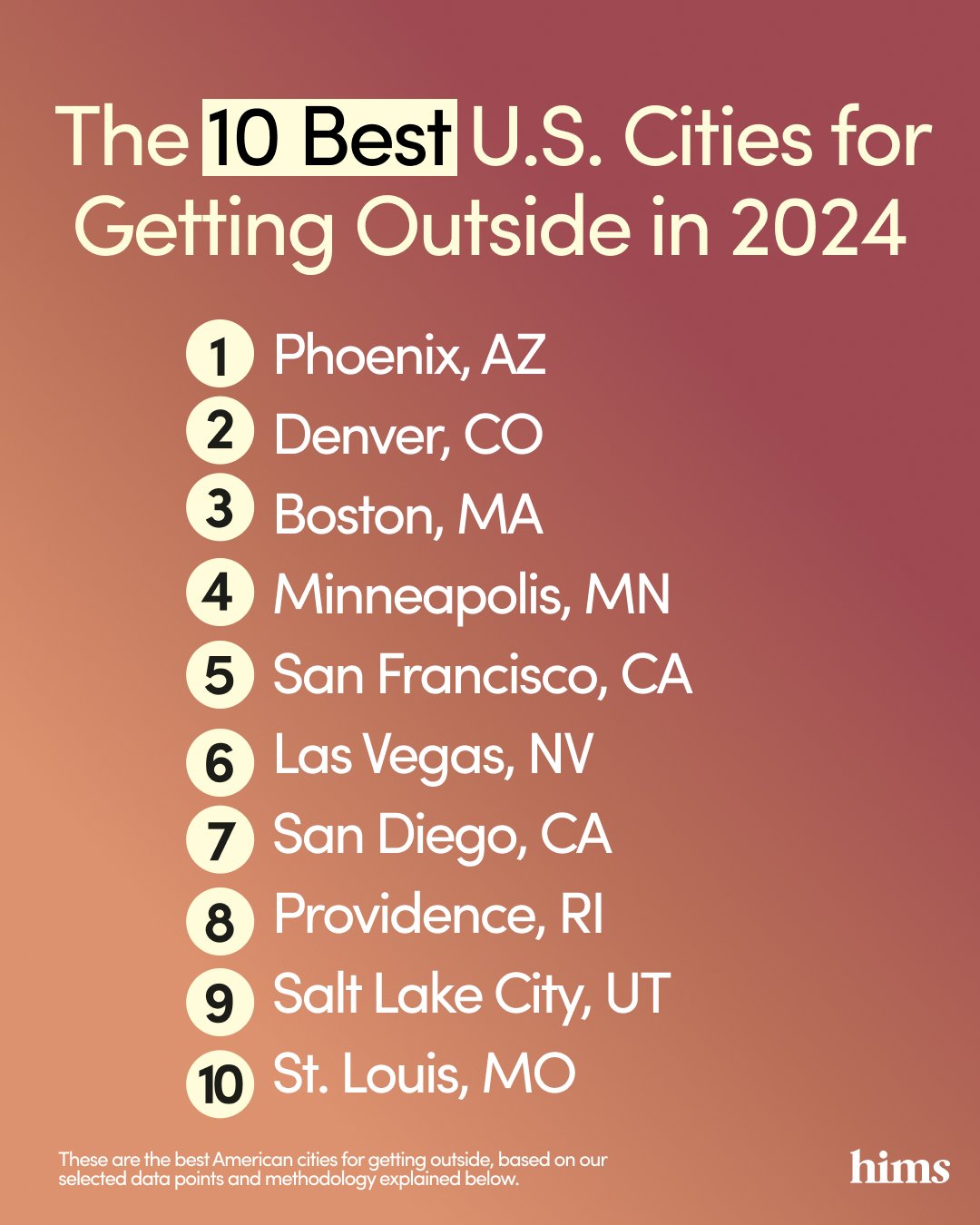
The best (and worst) U.S. cities for getting outside in 2024
This story was produced by Hims and reviewed and distributed by Stacker Media.
The best (and worst) U.S. cities for getting outside in 2024
Most American adults spend a majority of their day in front of a screen.
This increasingly sedentary lifestyle can cause a number of adverse health side effects, including a higher risk of cancer, cardiovascular disease, diabetes, and more.
Going outside more frequently has the potential to improve health outcomes along with your mental health and quality of life. But where you live impacts how easy and convenient it is to spend time in the great outdoors throughout the year.
To find the best cities for getting outside in the U.S., Hims analyzed four data sets:
- Average amount of annual precipitation: It's more appealing to spend time outside when it's not raining. One study suggests that exercising outdoors instead of indoors resulted in increased energy and a decrease in tension and depression.
- Air quality: Exposure to air pollution can increase the risk of cancer, cardiovascular disease, respiratory diseases, and more.
- Number of outdoor activity establishments per 100,000 residents: Access to outdoor activities gives residents more options for getting outside. We compared the concentration of amusement and theme parks, golf courses, skiing facilities, and marinas to the city's total population.
- Number of environmental, conservation, and wildlife groups: Research shows that exposure to greenspaces has health benefits, and environmental advocacy groups can have a major impact on preservation and conservation efforts.
Here are the results of the best and worst cities for getting outside.

Key Findings
- Phoenix ranks as the best city for getting outside thanks to a minimal amount of precipitation or hazardous air quality, followed by Denver and Boston.
- Six of the top 10 best cities are in the Western U.S., including Phoenix, Denver, San Francisco, Las Vegas, San Diego, and Salt Lake City.
- Birmingham, Alabama, ranks as the worst city for getting outside due to heavy rainfall throughout the year, poor air quality days, and a lower concentration of outdoor activity establishments.
- Southern cities like Birmingham, Nashville, Tennessee, and Raleigh, North Carolina, topped the list of the worst cities for getting outside.
The Best Cities for Getting Outside: Trends and Insights
Let's break down the best and worst cities in each category before looking at the overall rankings.
Which Cities Have the Most Precipitation?
It's a lot easier to get outside and stay active when the weather is dry. That's why we looked at annual rainfall to find the cities where you can get outside and be active, whether you're running, walking, or playing sports.
Lowest Amount of Precipitation Each Year
- Las Vegas, Nevada
- Phoenix, Arizona
- Riverside, California
Highest Amount of Precipitation Each Year
- Miami, Florida
- New Orleans, Louisiana
- Birmingham, Alabama
It's not very surprising to see that desert areas like Las Vegas and Phoenix have the least amount of rain each year, while cities closer to the hurricane-prone Atlantic Ocean and Gulf of Mexico are subject to more precipitation.
Which Cities Have the Best Air Quality?
Air quality has a direct impact on health, and the biggest culprit is fine particulate matter (PM 2.5). We looked at the annual concentration of PM 2.5 in each city to gauge general air quality throughout the year.
Lowest Annual PM 2.5 Concentration
- Las Vegas, Nevada
- Virginia Beach, Virginia
- Denver, Colorado
Highest Annual PM 2.5 Concentration
- Columbus, Ohio
- Atlanta, Georgia
- Nashville, Tennessee
Which Cities Have the Most Outdoor Activity Establishments?
Next we looked at four types of outdoor activity establishments and how concentrated they are in each city. These outdoor businesses include golf clubs, skiing facilities, marinas, and amusement or theme parks. We calculated the amount per 100,000 residents to get a sense of accessibility.
Most Outdoor Activity Establishments Per 100K Residents
- Providence, Rhode Island
- Hartford, Connecticut
- Boston, Massachusetts
Least Outdoor Activity Establishments Per 100K Residents
- Milwaukee, Wisconsin
- Salt Lake City, Utah
- San Jose, California
Which Cities Have the Most Environmental, Conservation, and Wildlife Groups?
Advocacy groups for environmental, conservation, and wildlife causes can have a big impact on how land is used in an area. That's why we looked at how many organizations are located in each city.
Most Environmental, Conservation, and Wildlife Groups
- New York, New York
- Washington, D.C.
- San Francisco, California
Least Environmental, Conservation, and Wildlife Groups
- Buffalo, New York
- Memphis, Tennessee
- Oklahoma City, Oklahoma
The 25 Best Cities for Getting Outside in the U.S.
These are the best American cities for getting outside, based on our selected data points and methodology explained below.
- Phoenix, Arizona
- Denver, Colorado
- Boston, Massachusetts
- Minneapolis, Minnesota
- San Francisco, California
- Las Vegas, Nevada
- San Diego, California
- Providence, Rhode Island
- Salt Lake City, Utah
- St. Louis, Missouri
- Cleveland, Ohio
- Buffalo, New York
- Milwaukee, Wisconsin
- Detroit, Michigan
- Seattle, Washington
- Portland, Oregon
- Pittsburgh, Pennsylvania
- Sacramento, California
- Miami, Florida
- San Jose, California
- Virginia Beach, Virginia
- Austin, Texas
- Los Angeles, California
- San Antonio, Texas
- Philadelphia, Pennsylvania
The 25 Worst Cities for Getting Outside in the U.S.
These are the worst American cities for getting outside, based on our selected data points and methodology explained below.
- Birmingham, Alabama
- Nashville, Tennessee
- Raleigh, North Carolina
- Memphis, Tennessee
- Atlanta, Georgia
- Houston, Texas
- Charlotte, North Carolina
- Indianapolis, Indiana
- New Orleans, Louisiana
- Columbus, Ohio
- Richmond, Virginia
- Dallas, Texas
- Jacksonville, Florida
- Baltimore, Maryland
- Oklahoma City, Oklahoma
- Kansas City, Missouri
- Louisville, Kentucky
- Chicago, Illinois
- New York, New York
- Hartford, Connecticut
- Cincinnati, Ohio
- Tampa, Florida
- Orlando, Florida
- Washington, DC
- Riverside, California
Note: Based on data collected in July 2024. Get the data.
Data and Methodology: How We Scored the Cities
Our ranking for the best and worst cities for getting outdoors started with the 50 most populous metropolitan statistical areas in the U.S. We then looked at four categories influencing how easy it is to enjoy the outdoors:
- Average amount of annual precipitation: You're more likely to go outside when it's not raining. We looked at the average annual rainfall in inches using data from the National Centers for Environmental Information.
- Air quality: We looked at the annual average concentration of fine particulate matter (PM 2.5), using data from IQ Air.
- Number of outdoor activity establishments per 100,000 residents: Using data from the US. Census Bureau's County Business Patterns, we found the concentration of amusement and theme parks, golf courses and country clubs, skiing facilities, and marinas.
- Number of environmental, conservation, and wildlife groups: Also using data from the United States Census Bureau, we found the number of conservation organizations in each city.
Annual precipitation and air quality were given a 2x weighted ranking. Then, we averaged the total rankings for each city to determine the best and worst cities for getting outside.
Tips for Getting Outside for Healthy Living
Even if you don't consider yourself "outdoorsy," you can still spend some quality time outside and boost your activity levels each week. Here are a few ways you can stick to a routine at any level of intensity for fitness success.
- Set a goal. Research shows that spending at least 120 minutes outside each week can improve your health and mental wellbeing. It doesn't matter how the time is split up. Simply track how long you stay outside and shoot for a minimum of two hours in total.
- Incorporate at-home workouts. One of the best things about going outside for some physical activity is that it's accessible to everyone. In addition to walking or jogging, try adding some at-home workouts into your routine either at the park or in your backyard to help lose fat and gain muscle.
- Stay motivated. Be consistent with your outdoor time to reap both the physical and mental benefits (did you know exercise can even help with anxiety?). Motivation tips include things like finding your purpose, maintaining a positive outlook, and tracking your progress.



